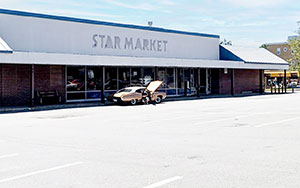
The redevelopment of various Winter Hill properties, such as the long-vacant Star Market site, was discussed at a recent meeting of the Winter Hill Civic Advisory Committee. — Photo by Luda Tang
By Luda Tang
The regular meeting of the Winter Hill Civic Advisory Committee (CAC) took place on August 11. It was mainly composed of the discussion of the Winter Hill Renewal Plan and the presentation from Mark Development and Beacon Communities on project’s updates.
The Winter Hill Renewal Plan is a portion of the general Winter Hill Neighborhood Plan, which has been an on-going project since November of 2016. The Urban Renewal Plan was launched to redevelop the underutilized properties at the heart of the Winter Hill neighborhood, including a vacant Star Market, two dilapidated, vacant parking lots, and three other buildings and a private right of way.
These properties have been deserted since 2007. To better serve the community, the Somerville Redevelopment Authority (SRA) was empowered to take charge of the renovation process.
The goals of the Urban Renewal Plan are drawn from the objectives of Winter Hill Neighborhood Plan, including things such as, “improving Winter Hill’s identity as a neighborhood-oriented main street commercial district,” “creating green and open gathering spaces to support community life and the environment,” “ensuring a pedestrian- and bike-friendly experience,” and “redeveloping vacant and underutilized properties into uses that better meet community needs.”
In addition to reviewing the objectives of the plan, Rachel Nadkarni, the Urban Revitalization specialist at the City of Somerville, also the host of the meeting, explained other sections of the plan as well. For example, maps that show the project area boundaries or the existing property lines and buildings.
Will Colan, a member of the Civic Advisory Committee, felt that showing strong support for the development team to pursue all kinds of environmental design, including green roof, solar opportunities, and passive house standards, might be good to add to the document. He also brought up a possible partnership with other city offices, like the Urban Forestry team, to create the best outcome for residents.
The second half of the meeting was centered around the updates presented by Mark Development team. Robert Korff, the founding principal of Mark Development, LLC, a real estate development company, introduced two major updates for the plan: the sustainability strategies for buildings and the findings from the parking lot study.
Jeff Geisinger, a director of sustainable design at Utile, a Boston-based design team, indicated that the team will target Passive House through the Phius 2021 core standard for the site. The Phius 2021 standard is the industry standard baseline for net-zero building design and emphasizes quality, durability, health, safety, and cost-optimized conservation as described by Phius website.
The Passive House is the cornerstone to achieve the Phius standard, meaning a performance-based building certification that focuses on the dramatic reduction of energy use for space heating and cooling, according to the Passive House Massachusetts website. The benefits include enhancing thermal comfort, exceptional indoor air quality, reducing carbon emissions, having better sound isolation, etc.
“We are proposing a comprehensive sustainability strategy on how we can create a health and sustainability environment both outwardly towards the communities and inwardly towards the residents and visitors to the buildings,” said Geisinger.
To better understand the parking occupancy data on the street, Damien Chaviano, the principal of Mark Development, LLC, described four in-field studies that the team have conducted in various time periods. They chose the area within two radii from the site, one is within 5-min walkshed and the other is 10-min walkshed. The study time was the middle of the weekday from 1:00 to 4:00 p.m., two were weeknights from 10:00 p.m. to 1:00 a.m., and the last one was the middle of Saturday.
Chavian specifically demonstrated the data within 5-min walkshed from the site. The vacancy percentage out of 1,776 capacity in the middle of weekdays is 53 percent. The number narrows down to the nearly 25 percent vacancy rate during two weeknights, and then goes up again to 39 percent for the middle of Saturday. The average of vacancy rate for these four studies achieves 35 percent, and that means 623 spaces available.
Chavian also used different colors to identify areas with different occupancy rates in the map. “We want the community to have benefits of these specific areas and really understand where that parking is relative to the site within the streets that you all live on,” Chavian said.















Respectfully as a Winter Hill Somerville resident:
1. Is the Walgreens portion of the property under eminent domain?
It is the only drugstore in the neighborhood we have access to?
2. Is the barber shop and winter hill liquors property under eminent domain?
These are small minority business owners. Please don’t displace them!
3. It is a fundamental American right to own property in this countryside . Please don’t steal someone’s property unless it absolutely for “The Public Good”.
All involved should have to prove to the Somerville tax payer that this is in the best interest of the taxpayer, not anyone else.
Best regards,
Sean P Cryts
Sean,
Walgreens is included in the development.
Liquor store is being left alone.